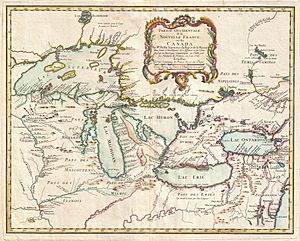Pays d'en Haut facts for kids
Quick facts for kids Pays d'en Haut |
|
|---|---|
| Territory of New France | |
| 1610–1763 | |
|
Flag
|
|
 Pays d'en Haut in New France on a map by Jacques Nicholas Bellin in 1755 |
|
| Capital | Quebec |
| History | |
|
• Established
|
1610 |
| 10 February 1763 | |
The Pays d'en Haut (pronounced "Pay-ee dahn Oh," meaning Upper Country) was a large area in New France. It was located west of Montreal in North America. This huge territory included most of the Great Lakes region. Over time, it expanded further west and south as the French explored more land.
The Pays d'en Haut was created in 1610. It was part of the colony of Canada until 1763. In that year, the Treaty of Paris ended New France. Both the Pays d'en Haut and Canada were given to the British. They became part of the Province of Quebec.
Contents
History of the Upper Country
In 1639, the French built Sainte-Marie among the Hurons. This was their first mission north of the Great Lakes. It was located along the eastern shore of Lake Huron.
In 1649, the Iroquois people destroyed the homeland of the Huron. French missionaries then returned to Canada. They brought the remaining Hurons with them. These Hurons settled in Wendake.
French Exploration and Goals
By 1660, France began to expand into the inner parts of North America. They had several goals for this expansion. One goal was to find a Northwest Passage to China. This was a hoped-for sea route across North America.
Another goal was to use the area's natural resources. These included valuable furs and metal ores. The French also wanted to convert the native people to Catholicism.
Fur traders started exploring the Pays d'en Haut. This was the "upper country" around the Great Lakes. In 1659, Pierre-Esprit Radisson and Médard Chouart des Groseilliers reached the western end of Lake Superior. Priests later started missions there. One example is the Mission of Sault Sainte Marie, founded in 1668.
In 1671, Father Jacques Marquette started a French mission at Michilimackinac. For the next 50 years, this place became very important. It was a stop for explorers and a center for talking with native groups. It was also a busy place for the fur trade.
On May 17, 1673, Louis Jolliet and Jacques Marquette began exploring the Mississippi River. They called it the Sioux Tongo (the large river) or Michissipi. They traveled as far as the mouth of the Arkansas River. Then they turned back upstream. They learned that the big river flowed toward the Gulf of Mexico. They had thought it would lead to the Pacific Ocean.
Expanding French Control
The French built many trading posts and forts to control the Pays d'en Haut. These forts helped them trade and show their power.
Northern Forts
In areas that are now Ontario, parts of Minnesota, and the eastern Prairies, several forts were built. These included Fort Kaministiquia (1679), Fort Frontenac (1673), Fort Saint Pierre (1731), Fort Saint Charles (1732), and Fort Rouillé (1750).
Southern Forts
In 1701, Antoine Laumet de La Mothe founded Fort Pontchartrain du Détroit. This fort became the main French military base in the region. Other forts helped strengthen this network. These included Fort Niagara (1678), Fort Crevecoeur (1680), Fort de Buade (1683), Fort Saint-Louis du Rocher (1683), Fort Saint Antoine (1686), Fort Saint-Joseph (1691), Fort Michilimackinac (1715), Fort Miami (1715), Fort La Baye (1717), Fort Ouiatenon (1717), Fort Chagouamigon (1718), and Fort Beauharnois (1727).
These forts helped France control the area. They also made trade with native groups easier. In 1717, southern parts of the Pays d'en Haut near the Mississippi River were moved. These areas, known as the Illinois Country, became part of Louisiana. Louisiana was a French colony located at the mouth of the Mississippi River.
French Settlements
The main French settlements in the Pays d'en Haut south of the Great Lakes were Detroit, La Baye, Sault Sainte-Marie, Saint Ignace, and Vincennes. Vincennes later became part of the Pays des Illinois, which was in Louisiana.
By 1773, the population of Detroit was 1,400 people. By 1778, its population grew to 2,144.
Four important forts protected the Pays d'en Haut. These were Fort Presque Isle (1753), Fort Le Boeuf (1753), Fort Duquesne (1754), and Fort Machault (1754).
Modern Use of the Term
Today, the name Les Pays-d'en-Haut refers to a specific area in Quebec. It is a regional county municipality in the Laurentides region, north of Montreal.
This area is the traditional name for a larger region in the hills northwest of Montréal. It is centered on the upper parts of the Rivière du Nord (Laurentides) river. The settlements there were founded long after the original meaning of "Pays d'en Haut" was no longer used. The TV series Les Belles Histoires des pays d'en haut takes place in this modern area.
See also
 In Spanish: Pays d'en Haut para niños
In Spanish: Pays d'en Haut para niños


